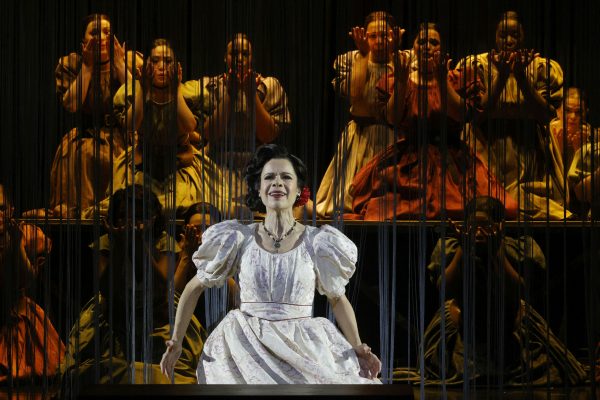“Disruptions,” by Steven Millhauser (Alfred A. Knopf, 270 pp, $28)
by Bondo Wyszpolski
Back in 2002, Jennifer Howard of the Washington Post Book Club wrote that “In another age, [Steven] Millhauser would probably have been an Andrew Lang or one of the Brothers Grimm.” Lang’s Fairy Books, published between 1889 and 1913, are still in print today; the Brothers Grimm, of course, need no introduction.
What was true in 2002 was also true in 1972, the year Millhauser published “Edwin Mullhouse,” his first novel (to be followed by a couple of other novels but mostly novellas and collections of short stories). I’ve followed him pretty much from the beginning, half a century now, and have usually enjoyed his fractured fairy tales with his Edward Gorey characters in Pleasantville.
Millhauser is probably underappreciated, although his novel “Martin Dressler” received a Pulitzer Prize, and his story “Eisenheim the Illusionist” was made into a move, “The Illusionist” (2006), starring Edward Norton, Jessica Biel, and Paul Giamatti.

There are 18 pieces in “Disruptions,” so let’s roll up our sleeves and have a look at them, shall we?
“One Summer Night” finds its young narrator stopping in at his girlfriend’s house, but she’s out and so is her father. The mother, however, is home, and we find ourselves edging closer to “Mrs. Robinson” territory. Nothing overt happens, yet it’s a game-changer in a very subtle way. The second story, “After the Beheading,” is not unlike many of Millhauser’s tales in which a small, conservative, bedroom community suddenly veers off track. A guillotine is set up in the town green, and there’s a public execution. If there’s an underlying stance, pro or con the death penalty, it’s a little hard to say, but the event, at the very least, is one of the “disruptions” cited in the title of the book.
In “Guided Tour,” a representative from AuthentiTours describes how the company recreated the story of “The Pied Piper of Hamelin” for 17 tourists who signed up to experience the fairy tale for themselves, including being led away from the town, just as the children were. “Late” is a stream-of-consciousness vignette about a man waiting in a restaurant for his woman friend to show up for dinner. His calculations as to when she’ll appear seem to avail him little. The title gives away the fact that she’s unlikely to show up early.
“The Little People” is a longish story about a walled-in or walled-off community of beings just two inches tall who live on two acres of land next to a town of normal-sized folks. Both sides mingle with one another, and despite the absurdity of the premise the story allows us to suspend our disbelief. Well, more or less. One couple, she from miniscule Greenhaven and he of the larger community, even marries, despite the discrepancy in size that’s even greater than that between King Kong and Fay Wray (or Jessica Lange or Naomi Watts). It’s a whimsical tale, to be sure, and perhaps there are lessons to be learned if one chooses to dig deeper.
In “Theater of Shadows” a community finds itself lured by silhouettes, their suggestiveness, and from this a love grows for the dim, inconclusive, the half-seen. “The Fight” is set in 1956, when the narrator is in eighth grade. He watches as two classmates go at it and then mulls over his own physical self. What if he’d been the one prodded, goaded into fighting? “A Haunted House Story” is just that, simple but compelling, with an ending to reflect upon.
With “The Summer of Ladders” we’re back to the small town community, and this time there’s a craze for taller and taller ladders. People aren’t just content with climbing 20 feet, but 60, 80 feet and maybe higher. It’s more along the lines of a bizarre fad that suddenly comes and just as suddenly is gone. In “The Circle of Punishment” everyone, children included, live “in a society of the punished. Punishment is our destiny, our way of life.” The logic here twists this way and that, and eventually the punishment is that of being excused from punishment.

“A Tired Town,” like several other stories here, is whimsical but not very substantial. The inhabitants of the narrator’s town get sleepier and sleepier, and soon personal chores let along social services begin to slip by the wayside. “Kafka in High School, 1959” certainly seems promising, the idea of the future Czech novelist and the author of “The Metamorphosis” growing up in an Anglo-Saxon middle class community. Section titles such as “Kafka Plays Ping-Pong,” “Kafka Attends a Party,” and “Kafka Works on His Tan” increase our anticipation. But is this really the Franz Kafka? Well, that’s for the reader to decide.
“A Common Predicament” maybe isn’t so common after all. A man has been dating a woman but apparently he’s never seen her face – she somehow has always kept her back to him, even in restaurants and other intimate encounters. But the story goes on too long, is not really that interesting, and crosses the line into being rather preposterous. Now we get to “The Change,” which is not what one would expect from Steven Millhauser. The author’s small towns always seem rather idyllic, even when they’re off-kilter (taking out the greenery, buying 60 foot ladders, etc). So here we have an account of a 15-year-old girl walking home from a party late at night and it’s pretty clear that she’s going to be sexually assaulted. The end of innocence, to be sure.
“He Takes, She Takes” is a back and forth word exercise along the lines of “he takes fire, she takes the heat, he takes her fancy, she takes his breath away,” and so on. The final story, “The Column Dwellers of Our Town,” is set once more in Millhauser’s quirky community, in which there are columns, 60 to 140 feet high, atop which sit and dwell members of the town who’ve decided to get away from it all. Think of Simeon Stylites who lived for 37 years on a small platform atop a pillar or column. Meanwhile, the town’s residents down below debate the pluses and minuses of this unusual phenomena, with more detail I think than is necessary which doesn’t bolster the so-so ending. It’s another variation of “The Summer of Ladders” and “After the Beheading” and a few of the other stories. It’s territory that Millhauser has often mined with success, but it’s also territory that he’s fallen back on with a little too much regularity, especially in the more recent books.
“Disruptions” has its moments, and they are delightful, yet there are even better ones to be discovered in the earlier collections, such as “Little Kingdoms” and “The Barnum Museum,” and also “The King in the Tree: Three Novellas.” ER










